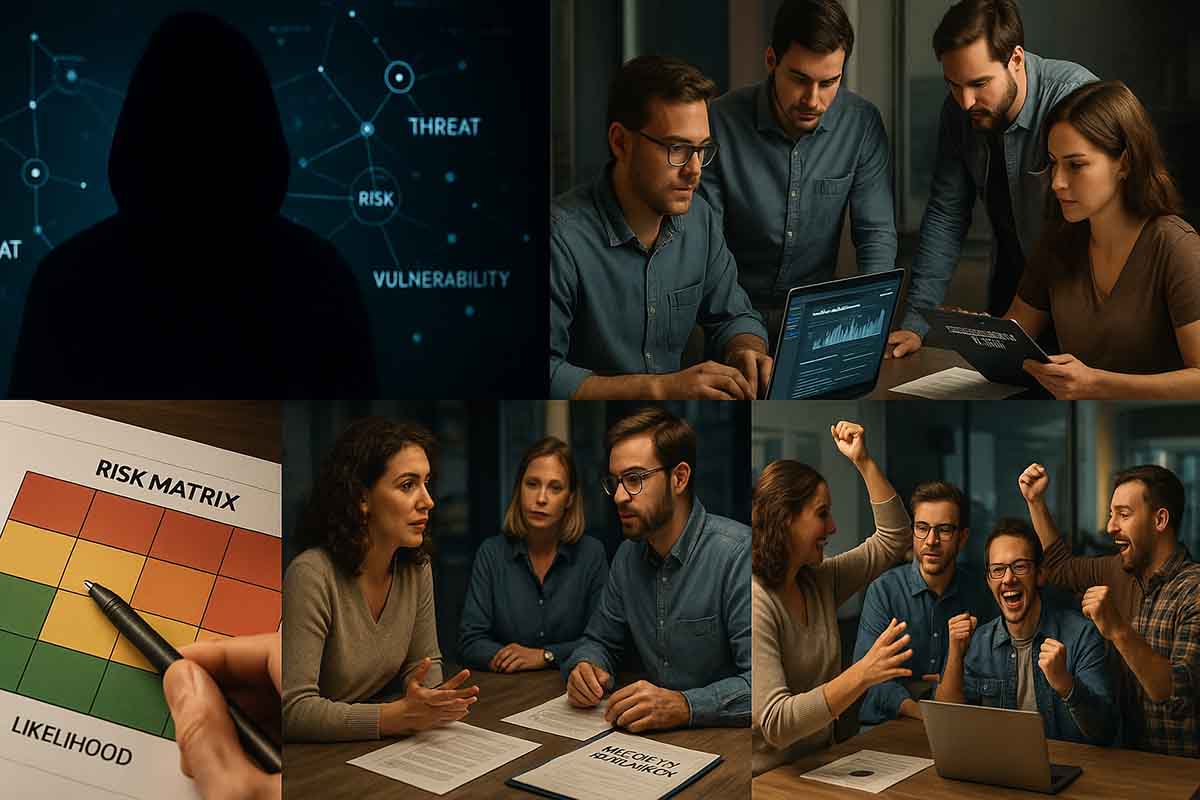
Identifying and Managing Cyber Risk for Digital Businesses
The internet seems boundless, yet it carries risks that can destabilize even the most secure companies. From data theft to major operational disruptions, threats evolve quickly and strike unexpectedly. For organizations in e-commerce, fintech, media, or any sector relying heavily on digital platforms, a regular cyber risk assessment is more than a checklist. It forms a core part of a responsible and forward-looking strategy. With a full understanding of potential vulnerabilities, businesses can make smart, informed decisions regarding budget allocation, technology upgrades, and staff development.
Quick Summary
- Covers everything from technical vulnerabilities to incident readiness and employee behavior.
- Helps prioritize investments, training, and action plans based on real risk scores, not guesswork.
- Uses global frameworks such as ISO/IEC 27005 and the NIST Cybersecurity Framework but tailors them to the organization’s specific culture and scale.
Why Cyber Risk Assessments Are Necessary
Cyber threats are not limited to outdated software or weak passwords. Attackers now use a mix of techniques like phishing, social engineering, zero-day vulnerabilities, and even artificial intelligence to breach defenses. According to reports from IBM and Verizon, incidents of data breaches are rising each year. These breaches cost businesses not just in revenue, but also in client trust, legal penalties, and reputational damage. Regulatory environments such as GDPR in Europe and CCPA in the United States require companies to be vigilant and accountable.
An organization unaware of its own weaknesses is operating without a safety net. Without visibility into its vulnerabilities, it becomes difficult to defend against intrusions or recover when something goes wrong. It is not enough to have tools in place. What matters is whether those tools and processes can withstand current and future threats.
The Most Common Threats Today
Cyber risk assessments go beyond software audits. They look at the entire organization, including employees, processes, third-party vendors, and infrastructure. Here are four types of threats that often show up across industries:
Phishing and Social Engineering
A German retail company once received emails appearing to come from its internal IT department. One employee clicked the link. That single action allowed an attacker to obtain login credentials and transfer money out of the company. The email seemed harmless, but the consequences were serious and immediate.
Ransomware
A medium-sized hospital in Canada experienced a full shutdown of its digital records after ransomware encrypted its main server. The medical staff had to switch to paper documentation. The hospital incurred financial losses, faced patient care delays, and even considered ransom negotiations.
Third-Party Breach
A Japanese manufacturing firm suffered a system-wide disruption when a small vendor in its supply chain failed to apply a critical patch. This unpatched vulnerability became an entry point for malware, which then infected the primary network and delayed production lines across several countries.
Zero-Day Exploits
A newly discovered vulnerability in a widely used software library was exploited before developers had released an official fix. One US-based media startup was hit, causing a service outage and customer data exposure.
These cases underline the point that cyber risk is not always internal. External actors and overlooked dependencies can become the very path through which damage is done.
Five Key Steps to a Complete Cyber Risk Assessment
1. Define the Scope Clearly
Start by listing all digital assets. This includes servers, web applications, mobile apps, cloud environments, internet-connected devices, and development tools. Clarify which services are in use, where they are hosted, and who is responsible for each one.
Being honest about what is running in your environment is the first step toward better security. Without full visibility, risk assessments can miss critical threats hiding in plain sight.
2. Collect Information Effectively
Use automated vulnerability scanners, configuration audits, and staff interviews to gather both technical and behavioral data. This step helps uncover not only exposed ports and weak encryptions but also common mistakes in employee behavior such as weak password habits or risky browsing.
Remember that human error often plays a role in security breaches. The assessment must look beyond software and analyze how employees interact with systems and follow policies.
3. Analyze Likelihood and Impact
For each vulnerability found, ask two questions. How likely is this to be exploited? And if it is exploited, what kind of damage could it cause?
Consider financial losses, legal exposure, operational disruptions, and reputational harm. Include both direct costs and downstream effects. For instance, a small data leak may seem minor until it results in lost customer trust or lawsuits.
4. Prioritize Based on Risk
Not all vulnerabilities need immediate action. Use a risk matrix to rank them by severity, combining likelihood with potential impact. Focus first on the issues that present the greatest danger.
Some problems might be too costly to solve right away. Others might be manageable with simpler fixes. The goal is to invest where it matters most.
5. Recommend Clear Responses
After ranking the risks, propose solutions. These might involve removing the vulnerability entirely, reducing its potential damage, transferring the risk to a third party through insurance, or monitoring it closely over time.
The response should match the threat. Not everything requires a full system overhaul. Some risks can be addressed through better staff training or simple policy changes.
How to Quantify the Findings
Large organizations often face long lists of vulnerabilities, many of which can feel overwhelming. To bring clarity, use three key metrics:
Likert Scale for Impact
Rate the impact of each risk on a scale from 1 to 5. A score of 1 might mean minor service interruption, while a 5 represents total system downtime affecting customers worldwide.
Frequency Estimate
Use past data, industry threat reports, and seasonal trends to estimate how often each type of threat is likely to occur.
Monetary Loss Range
Engage finance or actuarial professionals to estimate the cost range of a worst-case scenario. This can include both tangible and intangible losses.
Combining these three metrics provides a simple, defendable risk score. This score can be presented to leadership, used to justify budget needs, or shared with external partners to support decisions.
Global Standards That Provide Structure
There are several internationally accepted frameworks that businesses can use to guide their risk assessment efforts:
- ISO/IEC 27005
Part of the ISO 27000 series, this offers a well-rounded view of information security risk management. - NIST Cybersecurity Framework
Builds around five functions: Identify, Protect, Detect, Respond, and Recover. This cyclical model helps maintain resilience over time. - FAIR Model
Designed to quantify risk in financial terms, this is useful for CFOs making budgeting decisions. - CIS Controls
Provides a straightforward, step-by-step guide ideal for small businesses without extensive IT departments.
Using these frameworks does not mean a business must follow every detail. What matters is adapting the guidance to suit the company’s size, culture, and risk appetite.
A Real-World Example: Small Startup, Big Lesson
A digital payments startup in Kenya gained rapid success after launching a peer-to-peer transfer app. With a growing user base, its basic security model quickly became outdated.
The leadership team decided to conduct quarterly cyber risk assessments. During the first scan, they found an old library in the backend code that exposed the system to injection attacks. By addressing it immediately, they prevented a serious data leak.
Their small team did not have vast resources, but they acted early. As a result, the company grew safely and earned customer trust. This example shows that even young startups can detect and respond to threats if they remain proactive.
Creating a Security-Oriented Culture
Cybersecurity is not just the IT department’s job. HR, legal, marketing, and top management all have a role in maintaining safe operations. When every team understands the value of protecting data, adoption of good habits improves.
Encouraging two-factor authentication, enforcing strong password policies, and holding team-wide training sessions are not enough. Regular tabletop simulations are valuable, too. These allow teams to practice their response to realistic crisis scenarios and adjust plans accordingly.
Prepared teams recover faster. The sooner your people know what to do, the less damage a real incident will cause.
Continuous Improvement is Essential
The nature of cyber threats changes often. What worked last year may not be enough today. Risk assessments should be cyclical and evolve with the environment.
Update the scope regularly, refresh training content, and reevaluate tools in use. It is also helpful to engage with communities like FIRST or MISP. These platforms provide access to the latest global threat intelligence and fraud campaign patterns.
Working with others can reveal blind spots. It reminds companies that even if their internal systems seem secure, new threats are always emerging from the outside world.
Cyber risk assessment is not a one-time task that ends with a report. It is a living process that keeps your business resilient and informed. By understanding your vulnerabilities and measuring risk carefully, you create a strong foundation for responsible decision-making.
From there, you can build training programs, choose better tools, and allocate resources wisely. Most of all, you foster trust. Clients, partners, and regulators will see your organization not as a target, but as one that takes security seriously and is always ready.


No Comments